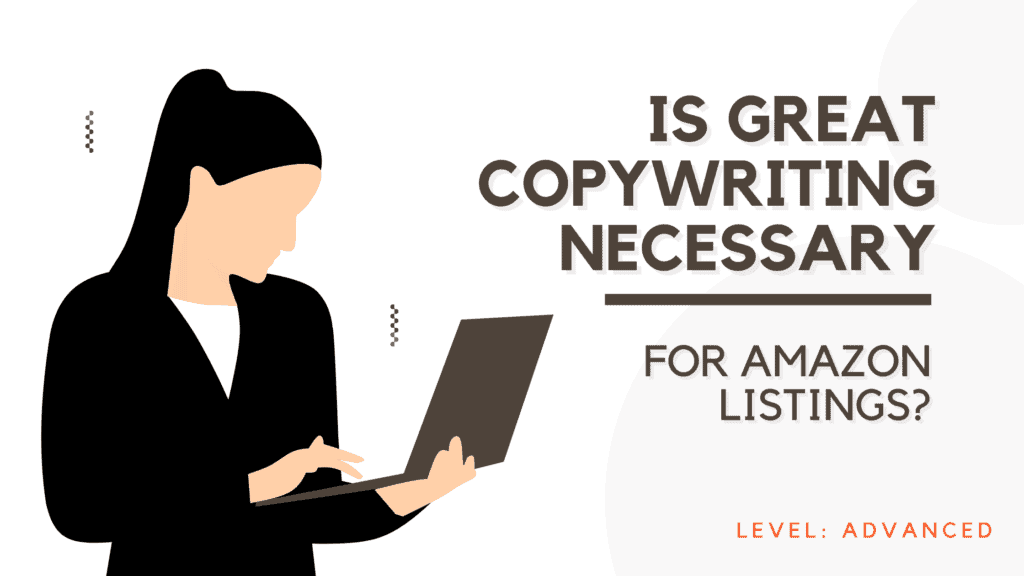Yes; but it’s easy to learn…we’ll teach you
While the barrier to entry into the world of selling on Amazon is low compared to other business models, there is still a learning curve. This is why there are many courses, many more dedicated Youtube channels, and other means of disseminating how-to-sell-on-Amazon information all over the web.

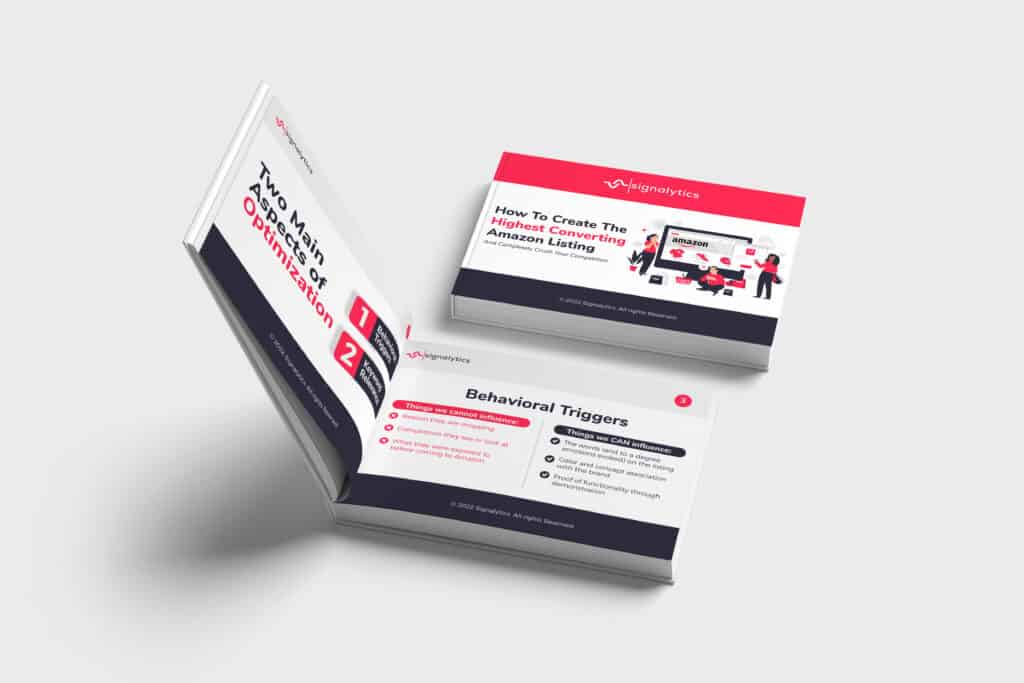
Get Our Internal Amazon Listing Optimization Operating System and increase conversions by 18%+ HERE 👇
One of the most often searched and desired pieces of how-to information on the topic is how to optimize an Amazon listing. In fact, we can see here that there was a recent spike in searches on the topic on Google…

Not only has the topic surged just in the last three months by over 900% but current bidding for ads using those keywords on Google is around $20+. It has even recently hit an all time new high in Google Trends.
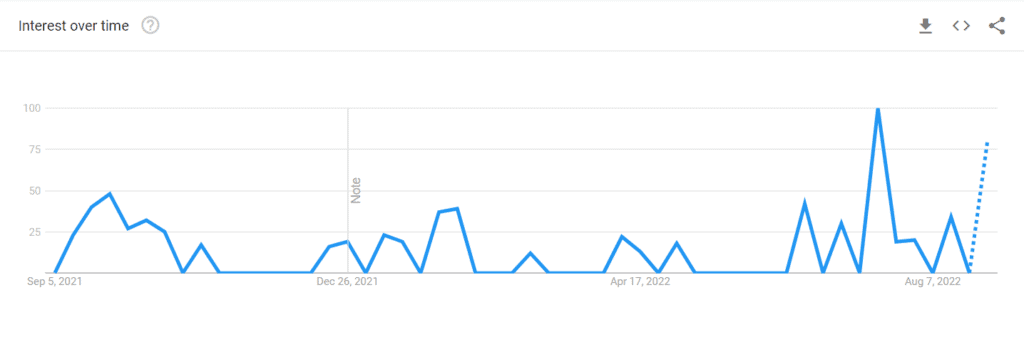
All that just to say it is an important topic for Amazon sellers. However, if you search to find a great resource on listing optimization you may discover the information lacking.
Current Optimization Topics Are Singularly Focused
Almost all articles and trainings on the topic of Amazon listing optimization are narrowly focused on Amazon’s style guidelines, character limits, and other technical details. To be clear, this is important information.
It goes over how long your title should be, how long each bullet should be, as well as suggested keyword density. The better articles on the topic even go so far as to teach how to do keyword research to determine what search terms should be scattered throughout the listing.
However, practically none of these articles go over one of the most fundamentally important topics with regard to Amazon listing optimization; copywriting.
The current education on the topic thoroughly covers the technical aspects of how to properly set up a listing, without going over how to effectively communicate an offer with potential buyers. No wonder so many sellers continue to struggle with this concept.
And perhaps the reason most don’t cover the topic of copywriting is because it seems intimidating, or they believe it to be too difficult. OR, in a more cynical instance, they don’t teach it because they want sellers to rely on them for their optimization services.
Their reasoning is unimportant, as the scope of this article is to teach simple methods for crafting stellar copy while also showing you that it isn’t too difficult for the average seller.
Two Consumer Brains
Before getting into the strategy behind crafting great copy, we must talk a little bit about the brain. Understanding how the minds of our customers and potential customers works will help create the best words possible for our listings.
The first thing we need to understand is that the consumer has two brains….!?
Um…what?
Ok ok. Not really. Actually we all have three brains! Referred to as “the triune brain” it represents the layers of brain that have evolved over time into what we humans now possess. It consists of:
- The reptilian brain – which controls autonomous functions such as heart beat, blood flow, liver filtration, hormone production, etc.
- The mammalian brain – the emotional brain, which controls motivation and emotion.
- The primate brain – controls higher cognitive functions such as logical thinking, conceptualization, etc.
But we simplify it into just two brains, as only the mammal and primate are involved in consumer purchases.
Understanding the Squirrel and the Ape

Now that we’ve narrowed down the brains to the two involved with consumer purchases, we can discuss exactly their role in the process.
The mammalian brain, which controls emotion, we can refer to as the squirrel. The primate brain, which controls logic, we can refer to as the ape.
Now imagine your brain is really the cockpit of the ship that is your body. Aside from being the head of the emotion centers of your mind, the squirrel is also typically the pilot in the cockpit 90% of the time.
The reason for this is because the squirrel is also in charge of your subconscious, or rather your unconscious self. See, higher-order brain function takes a LOT of energy to run. Your focused, logical brain (the ape) can only process about 40,000 bits of data per second. That may sound like a lot, but it actually is not.
Contrast that with the subconscious (the squirrel), processing 11,000,000 bits of data per second. That means the squirrel is taking in most of the information you are exposed to in a day. This includes everything you see, hear, smell, touch, and taste, as well as physical reactions to your surroundings, sense of balance, up-rightedness, and so much more.
This is the reason why you feel things (emotions) you sometimes don’t understand. Ever get a sense that something wasn’t right that you “just couldn’t put your finger on”? Yea, that was the squirrel trying to tell you something but lacking the fully formed rational explanation of the ape.
Back to the point; due to the immense energy and challenge the ape is faced with doing its job, the squirrel gets to fly the body most of the time. For this reason, most consumer purchases are emotion-based.
That is why they can happen so quickly. When the squirrel is in charge, you can decide to buy that mop in-the-moment. If the ape were in charge, you’d have to do a cost/benefit analysis and weigh the pros and cons for hours, if not days. If the ape ran the show, we’d hardly ever find the time to buy anything.
This is also why many B2B purchases take so much longer. Think about it; you’ve almost certainly purchased products in bulk from a supplier. But have you ever bought them immediately after being offered, sight-unseen? Not likely. This is because the ape requires due diligence.
When walking through the mall however, due diligence is not as crucial. So the squirrel lets you buy whatever your heart desires.
Ok, now that we’ve established that most of the time our brains are in an unconscious state with emotional centers ruling over most of our actions, let’s discuss how our brains read text…
Stitching a Story

Since most of our interactions with the world around us is unconscious, most of our communication is non-verbal. When speaking with someone else, this is why things like tone of voice, facial expressions, body language, word tempo, and such weigh so heavily on our interpretations of the message.
As such, written text is also interpreted mostly “non-verbally.”
See, when reading text, only a portion of what is read is the actual letters stitched together making words. The rest is your mind creating imagery that depicts what you are reading.
Basically, the squirrel puts together a story. If the text is boring and there isn’t much story to tell, it likely won’t evoke any emotions, and therefore will be harder to recall in the future.
Conversely, if the story is vivid, it will probably make you feel some things, and as such imprint memories that you can look back on later.
Alright, so what have we gone over so far?
- We humans interact mostly unconsciously with the world around us.
- Our squirrel brains are our emotional centers, and they are in charge (most of the time).
- As we read, our brains create images of the wording, crafting a story.
Now let’s get into the meat and potatoes of the topic; how to write copy that resonates with potential buyers.
Lesson One: Continuity
Since your would-be customers are reading your product detail pages, and as they are doing so their minds are creating mental images, the most important thing NOT TO DO is to not interrupt the story happening in their heads.
Things like shock, or interruptive patterns can be good for a message, as they can make it more memorable. That’s not what we are referring to here. Anything that makes the reader stop and go “I don’t understand that” or “what did that say?” will interrupt the story they are creating in their head.
This is why grammar and punctuation are so important. Maybe you’ve seen this meme before…
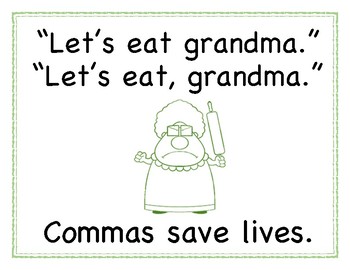
Let’s eat Grandma and Let’s eat, Grandma create two VERY different images in the mind. The key is to make sure the story in the consumer’s mind remains consistent. Things like mis-placed punctuation or the use of the wrong conjunction word can really derail what would otherwise be a great story leading up to a purchase.
But…all the copywriting gurus say that things like misspelled words don’t matter. Actually they can be good!
Yes, misspelled words, or even punctuation mistakes can humanize the text making it more effective ONLY IF IT DOESN’T INTERRUPT THE STORY. If the message is clear and the mistake is relatable, then it will work in favor of the text. However, anything that makes the message less clear will damage the intent.
What can you do? If you embark on writing your own listing, make sure you employ a proofreader. Have a native-speaker of the language you are writing in proofread your listing copy. You may consider having more than one person do it.
Their job isn’t to critique the writing or make suggestions (although you can do that too), but to simply make sure there aren’t any interruptions from grammatical errors or language nuances.
Lesson Two: Emotion/Benefit/Feature-Driven Copy
If you’ve ever read any copywriting tips you’ve probably heard all about how you need to “focus on benefits.” That is a great step in the process, but it isn’t the end goal. Let’s break down the three types of words so we can build a foundation for writing the most impactful listings possible.
- Features. These are the things your product has or can do. For example, if your phone charger can charge wirelessly, that’s a feature. Or if your yoga mat has an extra inch of memory foam padding, that’s also a feature.
- Benefits. These are what a customer will gain from the features of your product. So, if you sell a can opener with an ergonomic grip, your customer will be able to open cans without straining or exacerbating their arthritis. If you sell a hyaluronic acid fortified with collagen, your customer will see fine lines disappear in much less time.
- Emotions. These are how your customer will feel after receiving the benefit from your product. Your customer will feel safe and secure knowing they can see their home any time through your wifi-enabled security cameras. Your customer will feel accomplished having added exactly the right amount of garlic to their dish using your precise and easy to squeeze garlic press.
Utilizing all three of these types of words will maximize your results. The reason is because, as your customer is creating the story in their head reading your listing, your wording will do the following:
- Talking about the emotion they will feel will help color the story with that emotion.
- Talking about the benefits will help them depict use of the product.
- Talking about the features will help them understand the logic behind why the benefit causes the emotion (making it more believable).
But what if the space you have cannot fit all three of these elements? It’s almost like an algebraic formula in that the focus will change depending on who you are talking to. You need to study your market and determine who your ideal buyer is and then lean into which elements speak to them the most.
Know Your Market
If you know precisely WHO is buying your product (or, before launching, your direct competitor’s product) then you’ll know what speaks to them. One great way to learn what these buyers want is to read competitors’ reviews.
When you have a good sense of who you are talking to, you can know which elements will be most important to them.
If the reviews suggest they are more interested in how they will feel, then lead with copy that names their emotions.
If the reviews suggest customers are more interested in what products can do for them, then lean into the benefits.
If customers seem more interested in comparing stats and figures, then they are likely most concerned about listed features, so lead with that.
Include all elements where possible, but focus on what is most important to your audience.
Lesson Three: Use Descriptive Wording
Another tactic copywriting teachers push is using descriptive words. This is because they add clarity to the story.
To illustrate, imagine you read the following text:
A silicone baking mat.
Reading that, you probably pictured a vague, featureless, fuzzy representation of a potential baking mat. Or worse, you imagined a competitor baking mat you’ve seen in the past.
Now let’s add some descriptive language:
A white silicone baking mat with a red border, the size of a large cutting board.
Now the image in your mind is much more specific. The more specific to your product you can make the text, the more you can refine the customer’s mental imagery so that they have a realistic idea of what you are selling.
But…why does descriptive text matter when the listing has product images?
This is such an important question. Why does it matter? Because regardless of whether you have images, you need the story in the customer’s mind to be clear. The clearer their story, the more of an impression your listing will make.
Here’s an important thing to note: If a shopper pictures themself using your product, you are probably going to make the sale.
For this reason, the number one goal of your text in your product listing is to get shoppers to imagine themself using your product.
How do you do this? Simply be as descriptive as possible. Use a thesaurus and pick the words that most easily conjure mental images. Don’t use too much, just enough to get the point across.
Here’s another example.
For the purposes of an Amazon listing, just saying ‘it’s a hamburger’ is too vague.
However, saying ‘it’s a thick and moist, succulent, juicy, dripping, luscious hamburger’ is not necessary and will take up too much valuable space.
Instead, simply saying ‘it’s a thick and juicy hamburger’ conjures the image of a hamburger of decent size that drips when bitten into. This is often equated with better taste than a dry burger.
So don’t over-complicate this part. Be descriptive. Use strategically selected words that convey enough of a message to conjure a mental image.
Lesson Four: Capitalizing on Associations
If we’re talking about evoking emotions, using few enough words to get the point across, and speaking directly to a target audience, then we’ll need to utilize the mental associations we connect to words.
In the above hamburger example, the words thick and juicy, when combined in this context, convey a greater likelihood of deliciousness due to associations. We associate those features when attached to food (or specifically meat) with higher quality and therefore greater taste.
Another great example of this is the brand name Gorilla Glue. We associate inhuman strength with gorillas and that conveys the message that the glue/adhesive is incredibly strong. It also uses less characters than typing out “Incredibly Strong Glue.”
So using associations in words is critical to effective copywriting, especially when you have limited space.
Lesson Five: Call Out Your Audience
After you get to know your audience, the best way to ensure they feel seen is to call them out specifically. Everybody wants to sell a product that anyone can use, but if your product is for everyone, it really is for no one.
If you specifically call out who your product is for, or what specific instances it is best used in, you will see much better results.
This includes: what products it is compatible with, or what specific challenges it is best used against, or what demographic has enjoyed it the most in the past.
Examples of this would be things like…
- For people with discerning taste
- For moms who love to be close
- For people who have trouble getting up the stairs
- For people with a 46in by 54in grill
Implementing on the Listing
Now that we have created a foundation with understanding what is going on in your potential customers’ minds, understanding what words to use, and understanding how to use those words strategically, we can move to implementing those things in the various sections of an Amazon listing.
Title
The Title is, unequivocally, the most important text in your listing. While Amazon is definitely a very different platform than Google, it takes many cues from the search engine. One of those cues is in prioritizing and weighting keyword relevance in the title.
Aside from assigning relevance to the keywords within it, the Title also informs shoppers what product they are looking at. Remember how we discussed the “non-verbal” nature of how our brains work? So, shoppers aren’t only looking at the main image, but using the main image and title to create an inference of what item they are about to look at.
That means the Title needs to be relevant to both the Amazon algorithm as well as potential customers.
To craft a title in this way, first identify your primary keyword. Then form the most relevant long tail key phrase from that. Once you have your primary long tail key phrase, use that to create an emotional, benefit-driven, feature-rich title.
Where possible, you’ll want to use emotion evoking, impactful words with deep associations. The thing about evoking emotions is that, it isn’t always about naming the emotion or using specific words. It’s primarily about knowing your audience. What are THEY looking for? If you give that to them, they’ll feel something.
Let’s look at some examples to illustrate these points.
Here were have a baby carrier listing from a large and successful brand:
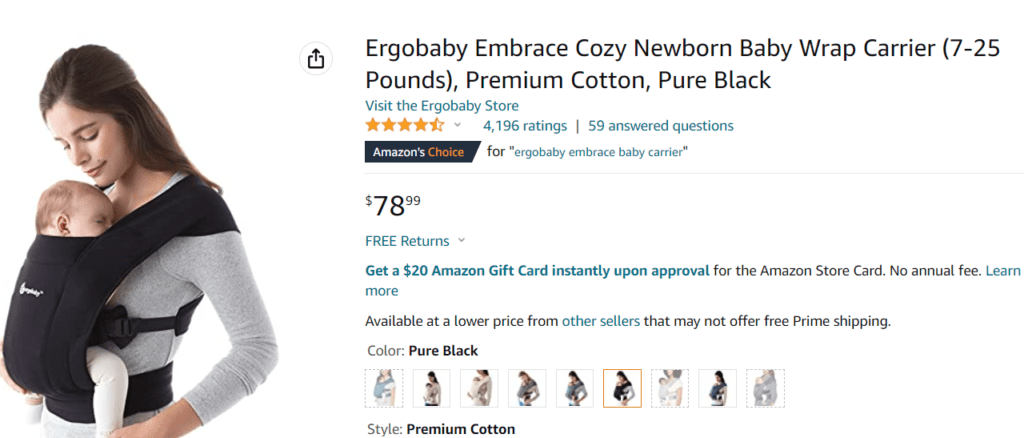
The Title is actually pretty short, but does the job nonetheless.
Ergobaby Embrace Cozy Newborn Baby Wrap Carrier (7-25 Pounds), Premium Cotton, Pure Black
First, because of the nature of this specific niche, the brand name is the first word. In this niche, brand loyalty is a big factor, so displaying the brand is beneficial. Likely many sales come from referrals so immediately that gets the attention of shoppers.
Next, the name of this particular type of carrier is called Embrace. It was very clever of the brand to use a word with meaning AND emotion to name the product type (strong associations there). For a baby carrier, the word “embrace” is powerful.
Then we have descriptive words like “cozy” and “premium” and “pure.” Not only do these describe, but they also have associations of their own. Think about it. We all know what cotton is, but what makes it premium? Maybe nothing, but automatically most of us would look at that and believe it is constructed from a superior material.
And what exactly is the difference between black and “pure black?” Further, why would anyone care if the color of their baby wrap was “pure?” Likely they wouldn’t, but again, the word “pure” has associations with quality and that was the intention behind the word.
Outside of those words, the rest of the information names who the product is for, specifically, by naming that it is a newborn wrap for 7 to 25 pounds. Notice that it spells out pounds rather than using the abbreviation lbs. This was undoubtedly so that there is no confusion.
So this title is very clear as to what the product is and who it is for, while using descriptive words that conjure images of superior quality, while also touching a bit on the emotion it will bring. Outstanding.
Let’s continue with another example.
Next we have “Amazon’s Choice” for the keyword “can opener”:
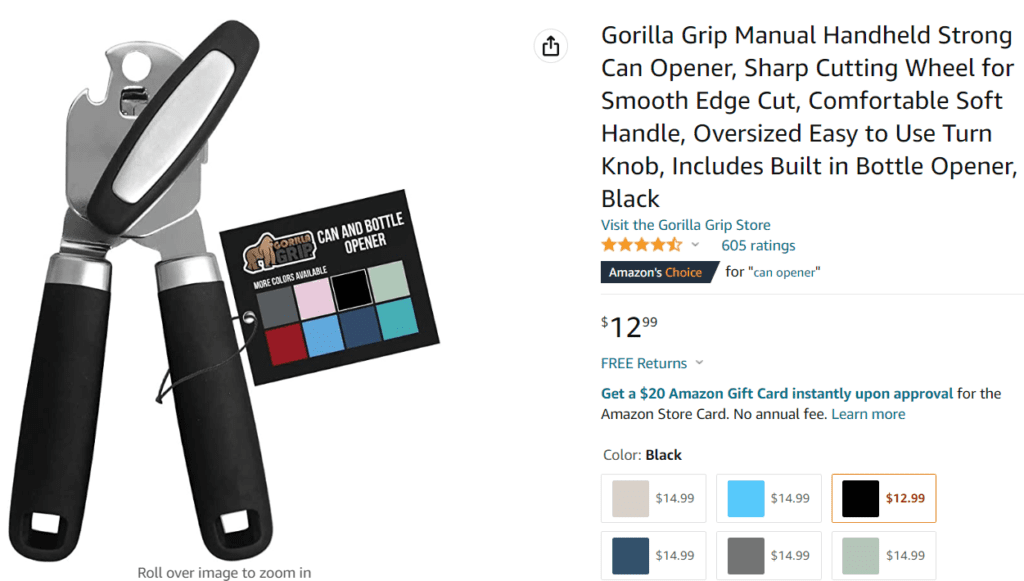
Gorilla Grip Manual Handheld Strong Can Opener, Sharp Cutting Wheel for Smooth Edge Cut, Comfortable Soft Handle, Oversized Easy to Use Turn Knob, Includes Built in Bottle Opener, Black
Here we see the brand name is placed up front, but there seems to be good reason why. The name itself evokes a sense of strength as it is called “Gorilla Grip,” (much like the earlier Gorilla Glue example).
Descriptive words like “strong,” and “sharp,” and “smooth,” and “comfortable” help the shopper to understand this product will enhance their life with ease and convenience. Specifically the inference from the phrases “comfortable soft handle” and “oversized easy to use turn knob” show that while emotion evoking words weren’t used, shoppers may still be able to sense how they’ll feel using this product.
This is because it is a very specific market segment this language is speaking to (usually the elderly who have trouble using tools like these). These customers likely prefer to know the benefits of their products as they have specific needs to be met.
The title is less clear than a perfect title should be, but nonetheless it covers the bases by also naming its features; can opener, cutting wheel, handle, with bottle opener, etc.
We’ll go over one last example and then discuss what we can learn from these.
This plain, mundane product not only has the Amazon’s Choice badge for its main keyword but also has a BSR of less than 50!
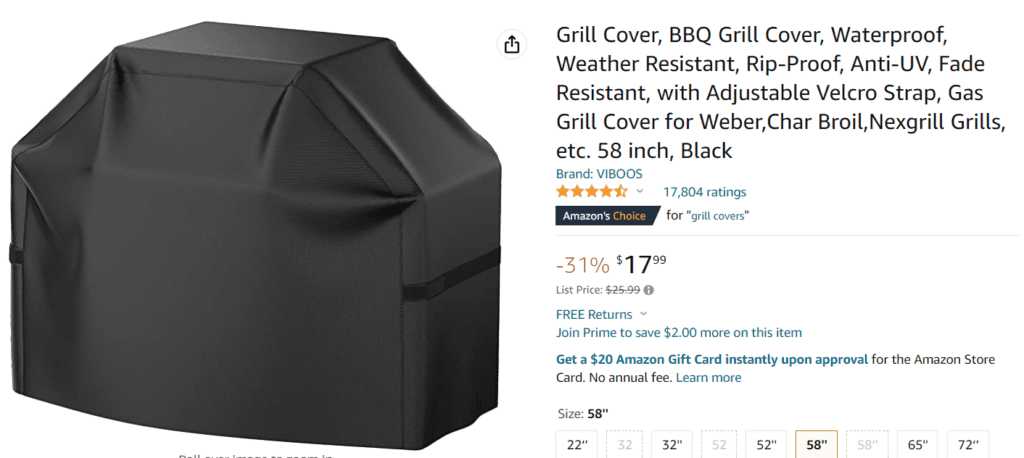
Grill Cover, BBQ Grill Cover, Waterproof, Weather Resistant, Rip-Proof, Anti-UV, Fade Resistant, with Adjustable Velcro Strap, Gas Grill Cover for Weber,Char Broil,Nexgrill Grills, etc. 58 inch, Black
The title does unnecessarily repeat the keyword “grill cover” but nonetheless conveys exactly what the product is in the first few words. Immediately it launches into features, but for this niche the features are what customers are searching for (and they also infer their benefits). That is why we see “Waterproof, Weather Resistant, Rip-Proof, Anti-UV, Fade Resistant.” Undoubtedly this addresses issues with wear and tear customers of competitors have experienced.
The title also explains who the product is for by addressing the grill types it can be used on. This is clever as the title will likely benefit from the rank juice from the brand names as well.
One might make the argument that this title didn’t evoke emotion, but it did speak directly to its target market. If the market are avid grillers who are generally proud of their grill creations, then speaking directly to their desire to have a TOUGH and WEATHER PROOF cover that will protect their precious grill is exactly what will evoke emotion.
What We Can Learn From These
Putting these examples together these are the lessons for making a stellar Title on Amazon:
- Identify the primary keyword(s). Create the most relevant long tail key phrase from it. Use this as your keyword focus in the Title.
- Read customer reviews of direct competitors. Get an idea of what is important to your future customers. Are they driven by emotional language, benefits, or feature comparison?
- Using the knowledge of your target market, craft a title that focuses on their preferred communication style. Attempt to include all elements where possible (emotion, benefits, features).
- Do not keyword stuff. Write in a professional and descriptive manner but also speak to your human readers first.
- Use as few words as possible to convey the desired message. Remember to utilize words with strong associations.
- Call out specifically who your product is for.
Bullets
The Product Details, dubbed “Bullets” by Amazon sellers, is the intended space for more details on the features of the product. This is an important section because it goes into greater detail on not only what the product can do for a would-be customer, but also why the product should be chosen over competitors.
Typical best practice for product Bullets is to separate each bullet into two sections; a “headline” or otherwise shorter summary of the emotion/feature/benefit, and then a longer description. This is so people who prefer to skim text can see the information at a glance, while those who prefer to dive deep can read the more in-depth analysis.
Here is a decent example from an Automotive bestseller:
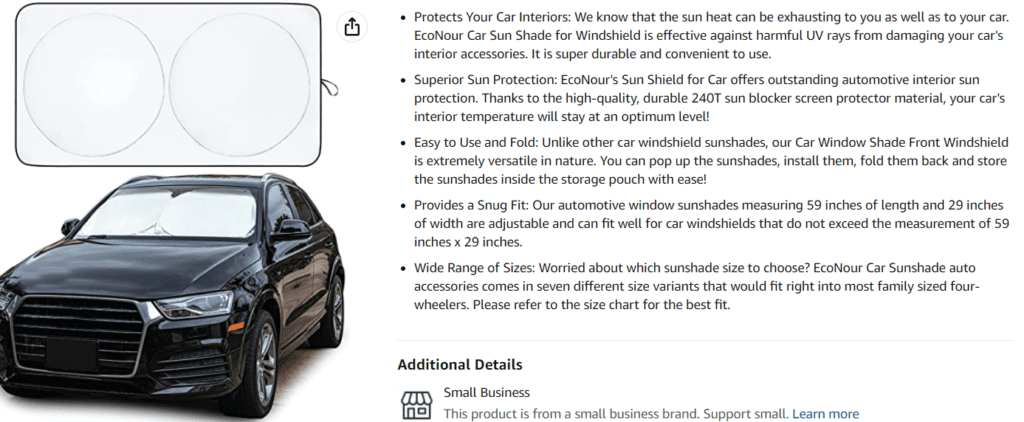
The first sentence in each bullet is the summary and is written like a title with every first letter capitalized. After the colon there is more detail. The copy is very benefit-driven while naming the features responsible. All in all this is well-written. It could use a little more emotional coloring to be optimal, however.
An example of a potential improvement might be that “you’ll feel safe knowing that your car’s interior won’t get UV faded” or that “you can rest easy because your car’s interior is protected.” Simple elements like that help paint the picture of the feelings alongside the benefits and feature use.
These bullets also missed a great opportunity to call out a big market segment. By saying something like “if you care about your car” or “if your car is your most prized possession” it would call out people who would buy this because they are fond of their car.
So, to write the best bullets possible follow these rules:
- Repeat your long tail title key phrase at least once. Pepper other relevant key phrases throughout the bullets as well.
- Segment into two parts; a summary and more detailed, to appeal to two different types of readers.
- Use all three elements to describe your product; emotions (focusing on how the customer will feel using it), benefits (focusing on what the customer will get from using it), and features (explaining how the product provides those benefits). Lead with the one that is most relevant to your market and use the other two as support.
- Call out who the product is for. Make the people who fit that audience feel like you are talking to them and that you made this product for them.
Description
The Product Description is one of the most overlooked portions of a listing. This is because, on the desktop layout, you must scroll to the bottom of the page to see it. It is most assuredly a mistake to ignore the description, however.
For one thing, the description appears directly under the title and images on mobile layout (as opposed to the bullets). Also, because there is no rigid structure (it is a block of text rather than character limited lines) you have the most freedom to be creative.
In the absence of A+ content, the Product Description is a great place to tell a story. Most of your competitors are using this space (if they do at all) to simply reiterate what has already been displayed in the bullets, so you have the opportunity to stand out by simply telling a story from the perspective of a customer.
Put your potential buyer in the specific instance where your product would shine the most, and describe the results. For example, imagine you sell a pet brush. Your story could resemble this one:
The in-laws are coming in town and will be over for dinner. You’ve been cleaning the house most of the morning. Then you remember your big, beautiful yet incredibly furry Golden Retriever who usually leaves clumps of hair ALL OVER THE COUCH!
Oh no! But you aren’t worried. Because you use the XYZ Brand pet brush to brush away the excess fur once a day. You have a ton of things to clean, but the couch isn’t one of them.
Get creative. Be specific and call out a typical scenario your target audience is likely to encounter. Just remember to also describe how they’ll feel and how they’ll benefit from using your product.
Also remember to mention your main long tail key phrase at least once in the description as well.
Images
Imagery may not have much to do with copy, but there are still some important copywriting elements to consider.
First, reviews are incredibly important to shoppers as they prove that their tribe (other people like them who need the same product) have already tested it and either approve or don’t. Because of this, including reviews in your images will be helpful.
By depicting your target audience, so the shopper sees someone just like them, and then adding a review at the bottom of the image, the soon-to-be-customer will feel like your product is exactly what they need.
Next, infographics are also powerful. These are images that include text for greater clarification. It should be noted that using images that don’t require text is optimal, but sometimes a little added text can really help people conceptualize the use of a product, especially when it is complex.
Just remember when creating infographics to use as little text as possible. The purpose of the text is simply to assist the imagery in displaying what emotions, benefits, or features the customer can expect.
Here’s an example…
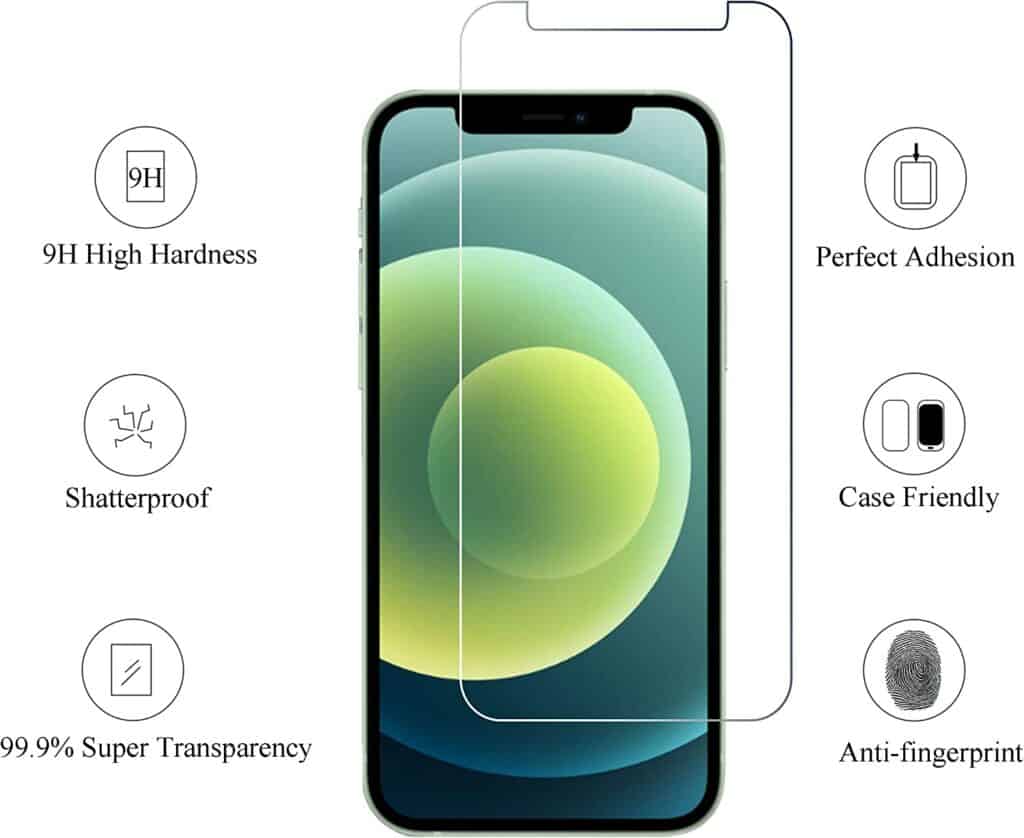
It is really difficult to display the benefits of a cell phone screen protector since it is merely a piece of clear, tempered glass. This infographic simply reminds shoppers of how the glass will protect their phone.
A+ Content
In case you couldn’t tell by now, stories are an effective way to convey a message. Your potential customers are already creating a story in their heads. You can help this along by telling one of your own (as described in the section on Product Description).
As such, one of the best uses of your A+ Content space is to tell your brand’s story.
All the product details have already been shared in the listing. Features, benefits, emotional implications, all are covered. Now is a great chance to develop a connection with your audience by telling them about your brand, its founders, what it stands for, and who it was designed to serve.
Here’s a fantastic example from a top selling brand in the Grocery category:
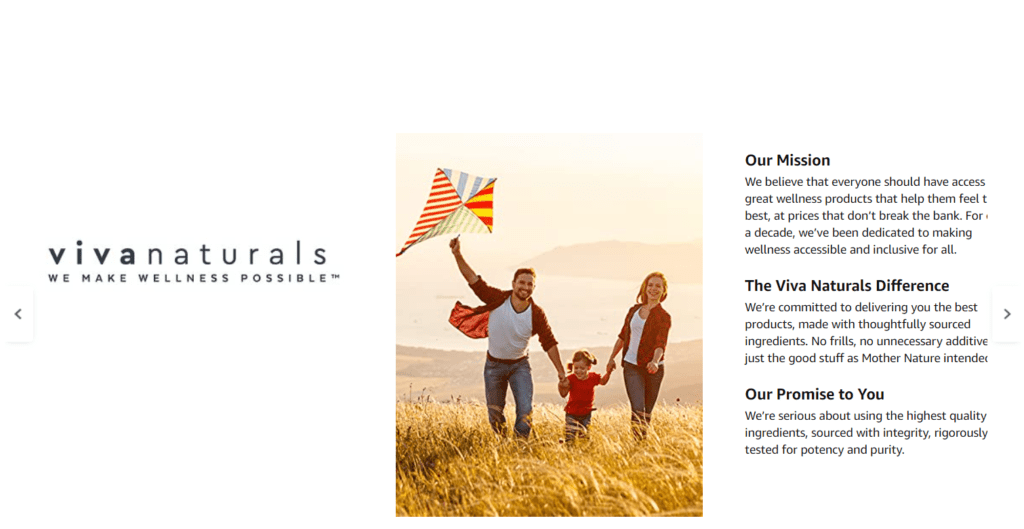
Their A+ Premium section has a lot more information but notice how the very first message is one that talks about the brand, its mission, and who it serves.
Putting It All Together
Ok, so the foundation of great copywriting is understanding how our minds work. We must understand that the squirrel is in charge and that purchases on Amazon are generally made to satisfy emotions.
We must also understand that as we read our brains stitch together a story using mental imagery. As such, if we want to write effectively we must help create as clear a mental picture as possible.
That means committing to the continuity (no major errors), using descriptive wording, using words with strong associations, and helping paint the picture of the emotions they will feel.
Another foundation to great copywriting specific to product listings is understanding what the target audience wants and what speaks to them.
Using these foundational elements we can put together a stellar listing, checking off these points:
- Find your product’s most relevant keyword. Then create the most relevant long tail phrase from that keyword.
- Read competitor reviews to get an idea of what customers want the most. Are they driven overtly by emotion? Is there a specific challenge they wish to overcome and therefore are seeking a specific benefit? Are they prone to brag and show off and looking for the greatest number of features?
- Create a clear and concise Title leaning into the communication style of your target audience and crafted around your relevant long tail phrase. Use words with strong associations to convey desired ideas while saving space.
- Use descriptive words to make the mental imagery clearer and call out specifically who the product is for.
- Create bullets that are separated into a brief summary and more in-depth explanation. Go over key benefits and the features that provide them, while also mentioning the end result and emotions felt because of it.
- Repeat your long tail key phrase at least once in the bullets. Pepper your bullets with other important keywords and phrases without stuffing (communicating with your human readers is top priority).
- Double down on calling out who the product is for or what specific challenges the product does best against.
- Tell a story about the use of your product through the eyes of your target audience in the product description. Be descriptive and make the story real and relatable.
- Repeat your main long tail key phrase in the description.
- Tell the story of your brand, what it stands for, and who it serves, in your A+ content.
Now go put these copywriting lessons to the test with your next listing. And if you need help, Signalytics has trained professionals who are well versed in utilizing behavioral triggers and consumer psychology to craft amazing listings that convert.

